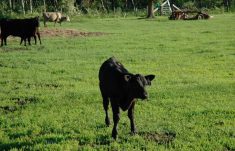When this issue hits your mailbox (on or around May 7), we’ll be at about the peak of one of the best meteor showers Earth sees this year. Wishing on shooting stars is silly at best, but if I see one — other than my standing wish for seven bucks and the winning 6/49 ticket that will buy — my wish is that when Prairie farmers, ranchers, veterinarians and farm writers do finally learn all we need to know about highly pathogenic avian influenza in cattle, we won’t have learned it the hard way.
“All we need to know” so far includes a lot that no one yet knows — so let’s start today with what we do know. Not so long ago, some strain of avian flu would appear every few years in one or more poultry barns somewhere. If the flu didn’t kill them, federal quarantines and culls awaited the remaining birds on affected farms. Eventually in such cases, Canada would again be declared avian flu-free and business would go on as usual.
Then, during a devastating run through flocks in the Eastern Hemisphere, high-path H5N1 made a jump to North America, starting in Newfoundland in late 2021. Whether via illness or euthanizing, the still-ongoing run of bird flu that followed has since killed just over 11 million domestic poultry and backyard birds at 422 premises across Canada, and over 90 million in 1,127 outbreaks in 48 U.S. states.
Read Also

Gentle treatments for pain in the neck
Heading toward year-end, people unknowingly tense up against the cold and busyness, causing neck pain that can often be treated with appropriate support and gentle mobility, athletic therapist Kathlyn Hossack says.
Despite the scope of this run of outbreaks, stamping-out remains the federal policy for avian flu in domestic birds. Food safety risks are slim to none, especially if meat or eggs are properly cooked. Rather, the public policy concern with such flu outbreaks has always been not only the effect on those livestock sectors, but also the chance of an animal flu virus adapting during these disease events to transmit more easily between species — as H1N1 did about 15 years ago.
Interspecies transmissions of this particular H5N1 flu had been relatively rare, though — mainly to individual wild animals, such as skunks, bears, foxes, seals and mountain lions. That is, until this March, when H5N1 was detected in newborn goat kids at a property in western Minnesota — and then in dairy cows in Kansas and Texas. For the first time, this virus had turned up in cattle.
As I write this (April 25) there’ve been detections of the virus in 33 dairy milking herds in eight states, as far north as Idaho and Michigan, and none yet in Canadian cattle. And while recent sequencing of the virus shows people still can’t catch it easily from exposure to animals, one person exposed to dairy cows that were presumed infected in Texas has been confirmed with the virus. According to the U.S. Centers for Disease Control (CDC), that person — whose only symptom was similar to pinkeye — is being treated with antiviral drugs and recovering.
USDA says it does “not anticipate the need to depopulate dairy herds” where H5N1 is found in cattle. Infected cattle so far are reported to be recovering — with “little to no mortality” in those herds. Milk recalls are also not deemed necessary; commercial milk is pasteurized before going to market. Milk production may decline at the herd level, USDA said, and clinical signs in “severely impacted” cows could include reduced feed consumption as well as “thicker, concentrated, colostrum‐like milk.”
Other known symptoms — among those infected cows that show any — include decreased feed consumption and rumen motility; abnormal tacky or loose feces; lethargy, dehydration and fever.
What we don’t know
Now: no one can yet say for certain exactly how these infected dairy cattle got or spread H5N1. USDA says it “has identified spread between cows within the same herd, spread from cows to poultry, spread between dairies associated with cattle movements, and cows without clinical signs that have tested positive.” USDA’s Animal and Plant Health Inspection Service (APHIS) has said migratory birds are believed to be the initial source, although pigeons, blackbirds and grackles — not particularly migratory by nature, any of those — were found dead on infected dairy premises in Texas.
APHIS also notes the virus is “shed in milk at high concentrations” but isn’t significantly concentrated in “respiratory samples” like nasal droplets — which suggests the main cow-to-cow route is not via the air. We know that starting April 29, the U.S. will require lactating dairy cattle to test negative for H5N1 before any interstate travel.
We also know there’ve yet to be any detections in any commercial beef herds in either the U.S. or Canada — and we know beef producers and veterinarians are advised to watch for symptoms. Past that, for our readership here in the West, home to the vast majority of Canada’s beef herd, the suspense of not knowing is palpable.
If we accept that wild birds were a source, how likely is it now that Canadian beef cattle will catch it, given that we’ve been hearing northbound geese honking overhead for weeks now? For that matter: how is it that Prairie beef cattle, exposed year-round to the outdoors, haven’t yet presented with this virus while it’s been killing birds coast to coast for over two years? We don’t know.
We do know APHIS spotted a shift in an H5N1 sample from a dairy cow in Kansas that could show the virus has adapted to mammals — but further analysis at the CDC showed the substitution was already seen in earlier H5N1 cases in mammals and “does not impact viral transmission,” so the CDC hasn’t changed its overall risk assessment for the public.
READ MORE: Flu strain in U.S. dairy cattle may be a different beast
All that said: would beef calves survive it? If unpasteurized milk direct from the source carries a high viral load, are nursing calves at risk? We don’t know. We know the most severe symptoms seen so far have been in older dairy cows in mid-lactation, but APHIS says the limited available data to date may not yet show a clear picture of the age groups at greatest risk.
Nor do we know yet how long it may take to develop an effective vaccine against H5N1 for cattle, given everything else we don’t yet know.
How is any of what I’ve written here helpful, you may ask? To which I can only reply: it’s more helpful than speculating wildly. To Prairie ranchers, I can suggest you may want to think now about where you might corral any infected cattle until they recover — and to keep an eye on our web site as more unknowns become knowns.
















